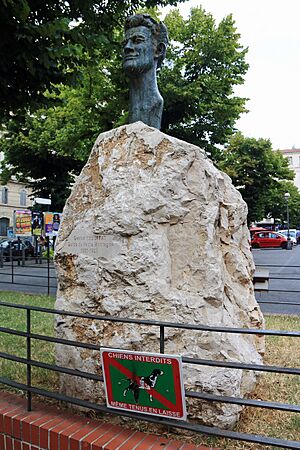Gaston Rébuffat facts for kids
Gaston Rébuffat (born May 7, 1921, in Marseille, France – died May 31, 1985, in Paris, France) was a famous French mountain climber, mountain guide, and writer. He is well known for being part of the first team to reach the top of Annapurna 1 in 1950. He was also the first person to climb all six of the great north faces of the Alps. In 1984, he received a special award, the French Legion of Honour, for teaching mountaineering to the French military. Gaston Rébuffat passed away at age 64. A special rock-climbing technique called the "Gaston" was named after him. A picture of Rébuffat on a mountain in the French Alps is even on the Voyager Golden Records, sent into space!
Contents
Early Life
Gaston Rébuffat was born in Marseilles, France. He started climbing when he was just 14 years old. He practiced in the Calanques, which are rocky cliffs near his home.
At 16, he joined the Club Alpin Français (French Alpine Club). Here, he learned about climbing big mountains. He met Lionel Terray, another French climber, who would join him on the Annapurna climb later. Rébuffat later moved to Chamonix, France. He became part of the Compagnie des Guides de Chamonix, a group of mountain guides. Soon, he began climbing in the Alps, where he spent most of his climbing life.
Climbing Career
Instructor and Guide
During World War II, Gaston Rébuffat attended a French youth training program. He finished in 1942 and became a certified mountain guide at age 21. This was quite young, as the usual age was 23!
He continued to teach climbing. In 1944, he became an instructor for the French National Ski and Mountaineering School. He also taught at the High Mountain Military School. His work as a military climbing instructor later earned him the Legion of Honour.
Rébuffat loved guiding people in the mountains. He once wrote that he "must live among the mountains." In 1945, he became a full-time mountain guide in the Alps. He guided many climbers, both new and experienced. By the 1950s, he was known as a top expert on the Mont Blanc Massif in the Alps. He even created several new climbing paths there.
Alpine North Faces
One of Rébuffat's most famous achievements was climbing the six great north faces of the Alps. These are some of the hardest and most dangerous parts of mountains to climb.
He started planning his first climb, the Grandes Jorasses, in 1938 when he was 17. In 1945, he successfully climbed its north face. In 1949, he climbed the northeast face of Piz Badile. By this time, Rébuffat was one of the best climbers in the world. This led to him being chosen for the 1950 Annapurna expedition.
Over the next few years, he guided other climbers up the remaining great north faces. These included the Petit Dru, the Matterhorn, the Cima Grande di Lavaredo, and the Eiger.
Annapurna
In 1950, Gaston Rébuffat joined an expedition to climb Annapurna 1. This mountain is in the Himalayas and is the tenth-highest peak in the world. The expedition was led by Maurice Herzog. Other French climbers like Louis Lachenal and Lionel Terray were also part of the team.
The climb started in March 1950, with the main ascent in May. They set up a base camp and four smaller camps higher up the mountain. The highest camp was about 7,400 meters (about 24,278 feet) high.
The very top of the mountain was reached on June 3, 1950, by Herzog and Lachenal. On their way down, the climbers got lost and had to spend a night in a deep crack in the ice. Everyone survived the trip. However, Herzog and Lachenal lost some fingers and toes due to severe frostbite. Even though Rébuffat did not reach the very top, he was very important in helping his injured friends get back safely. This expedition was the first time anyone had climbed a mountain over 8,000 meters (about 26,247 feet) high. It was the highest mountain climb ever at that time.
Writing
Gaston Rébuffat was known for his beautiful writing. He could describe both the dangers and the amazing joy of climbing. He wrote several books, and some he even published himself. His most famous book is Etoiles et Tempêtes, which means Starlight and Storm. It was first published in French in 1954.
- Starlight and Storm: The Ascent of six great North Faces of the Alps, 1956.
- Mont Blanc To Everest, 1956.
- On Ice and Snow and Rock, 1963.
- Men and the Matterhorn, 1967.
- Between Heaven and Earth, 1970.
Filmography
Rébuffat made three color films that showed him and others climbing in the Alps. These films show how skilled he was as a climber and how much he loved the mountains. His film Étoiles et Tempêtes won a big award at the Trento Film Festival in Italy.
- Flammes de Pierres (1953)
- Étoiles et Tempêtes (1955)
- Entre Terre et Ciel (1960-61)
- Les Horizons Gagnés (1974)
Rébuffat also helped direct parts of the Walt Disney mountain film Third Man on the Mountain.
Images for kids



